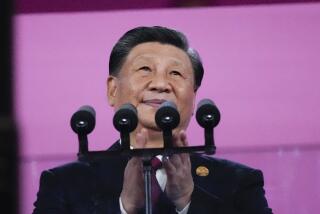Chinese riot police, Muslims clash in northwestern city
BEIJING — China’s worst ethnic violence in years broke out Sunday in the northwestern city of Urumqi, leaving 140 people dead and more than 800 injured.
The unrest pitted Uighurs, a long-aggrieved Muslim minority, against the Han Chinese, who increasingly dominate the far-flung Xinjiang region. With the death toll climbing over the course of the day, the violence appeared to be far deadlier than that last year in the Tibetan region.
Images from the city of 2 million showed flames raging from overturned cars and black smoke billowing over downtown.
Urumqi was virtually closed down today, with vehicles barred in much of the city, telephone lines and the Internet down.
Chinese bloggers wrote that at least one bomb exploded during the incident and that about 100 public buses were destroyed.
The Chinese government accused Uighur exiles in the U.S. of masterminding what was described by state television as a rampage of “beating, smashing, robbing and burning.”
But representatives of the Uighurs, a Muslim minority, countered that they were holding a peaceful demonstration that turned ugly because of government brutality.
“Under Chinese law, we should have the right for a peaceful protest against what the Chinese government is doing to our people,” Dilxat Raxit, a spokesman for the World Uyghur Congress, said in a telephone interview from his home in Sweden.
He described the incident as the most serious unrest in Urumqi, capital of Xinjiang region, where 8 million Uighurs live uneasily among the majority Han Chinese.
Witnesses reported that riot police arrived on the scene in armored personnel carriers, dispersing the crowd with water cannons and tear gas, and firing warning shots into the air.
At least 300 people were reported to have been arrested and 828 injured.
The trouble began shortly after 3 p.m., when about 300 Uighurs held a sit-in at People’s Square. Later, thousands of Uighurs began marching. By nightfall, riots had spread throughout the city, concentrated around the traditional market area known as Erdaoqiao.
Video that circulated on the Internet for a few hours before being removed by Chinese censors showed a crowd that appeared to be about 3,000-strong marching through the city. In another scene, people subdued with cuffs and ropes were lying on the pavement.
In what was emerging as a battle of images, Chinese television countered with footage of rioters overturning a police car. Two young women with blood streaming down their faces, who appeared to be victims, hugged each other and wept.
A man said to have been beaten by the mob was quoted by the official New China News Agency as saying, “They took to the street, not peacefully, carrying knives, wooden batons, brick and stone.”
The imagery bore an eerie resemblance to those that came out of Lhasa, the Tibetan region’s capital, in March 2008 when years of suppressed rage by Tibetans erupted in rioting. The Tibetan unrest dragged on through much of the year and threatened to mar the festivities around the 2008 Summer Olympics in Beijing.
It is unclear whether the Uighurs’ protests will have a similar effect during another sensitive year, in which Beijing is planning massive celebrations for the 60th anniversary of the founding of communist China.
Sunday’s protests were triggered by the June 26 killing of two young Uighur men at a toy factory in Guangdong province.
According to Uighur sources, the men were beaten to death by a mob, enraged by false rumors that they had sexually harassed Han women.
“Uighurs have suffered for years under racial profiling and unjust government policies that have painted the entire Uighur population as criminals and terrorists,” U.S.-based Uighur leader Rebiya Kadeer said in a statement released last week.
China considers Uighur activists to be criminals and terrorists for their opposition to Beijing’s rule over Xinjiang.
The news agency today quoted an unidentified Chinese government official as saying that “the violence was masterminded” by Kadeer.
Alim Seytoff, secretary-general of the Uyghur American Assn. and Kadeer’s spokesman, said in an e-mail from Washington late Sunday that the demonstrators were not separatists and that many had carried the Chinese flag on the march.
“They only asked the Chinese government to stop racial discrimination against Uighurs. . . . However, you will see what kind of brutal force they met,” he wrote.
The Obama administration has been struggling in recent months to resettle Uighur detainees who had been held at the U.S. prison at Guantanamo Bay, Cuba, since they were captured in Pakistan in 2001.
--
Tommy Yang and Nicole Liu of The Times’ Beijing Bureau contributed to this report.
More to Read
Sign up for Essential California
The most important California stories and recommendations in your inbox every morning.
You may occasionally receive promotional content from the Los Angeles Times.










